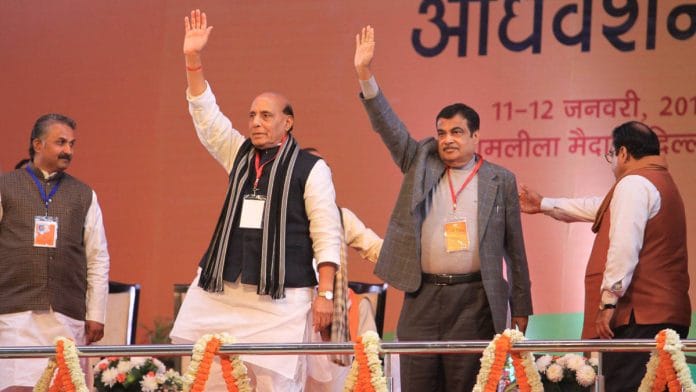On the first day of its national convention, the BJP passed resolutions on agriculture and welfare of the poor, claiming it had done better than the UPA.
New Delhi: The BJP Friday sought to re-establish its pro-farmer and pro-poor credentials, citing budgetary allocations and other measures to claim that the NDA government did much more for these sections than the previous UPA regime.
Weeks after its defeat in Madhya Pradesh, Chhattisgarh and Rajasthan was attributed to the alienation of the farmers and the poor, the BJP passed two resolutions – one on agriculture and the other on the welfare of the poor – on the first day of its two-day National Convention in New Delhi.
The resolutions were, however, silent on loan waivers – a demand made by the Congress.
The central government is also learnt to be considering the implementation of a scheme on the lines of Telangana’s Rythu Bandhu, entailing transfer of cash for every crop to farmers, but the resolution didn’t suggest any such plan.
Blame for the Congress
While the resolution on agriculture was proposed by Union Home Minister Rajnath Singh, the one on the poor was introduced by Minister of External Affairs Sushma Swaraj. The latter dwelt on how the Congress used the poor as its vote bank while doling out welfare measures in instalments.
“Congress remained in power for a long time but did not pay heed to improve the situation of poor, rather, it used them as vote banks… The then-Prime Minister Rajiv Gandhi himself accepted that out of Rs 100, only Rs 15 reaches poor. I do not need to say in whose pocket this Rs 85 was going,” said Swaraj.
Vision for agriculture
The resolution on agriculture, meanwhile, reiterated the government’s commitment to double farmers’ income by 2022.
“The BJP lauds its government for ‘successfully’ working out issues of farmers’ income. (In) the ‘New India’ that we are trying to create, we will not just be able to reach the goal of doubling of farmers’ income, but would also be looking forward from there… We are conceptualising an independent, able, strong and prosperous farmer as our annadata, who will take country’s economy to great heights,” Singh said.
The party said the total budget allocation in the agriculture sector now stands at Rs 2.11 lakh crore, as against the UPA’s Rs 1.21 lakh crore.
“In case of natural disasters, the agriculture sector has got Rs 32,000 crore from the National Disaster Relief Fund, which is 2.5 times higher than (under the) previous government. The allocations made to the states is 82 per cent more than the previous government’s allotment,” the party’s general secretary Bhupendra Yadav added.







What PM Rajiv Gandhi was referring to was not necessarily 85% diversion of funds. More to emphasise the high administrative cost of delivering services to ordinary citizens. The cost of governance remains forbiddingly high. In fact, across administrations, it is now the pure revenue deficit that is more troubling. Government’s capital outlays have been declining. No one who studies the current fiscal position of the Centre and the states – with the combined deficit over 6% of GDP – could feel sanguine. Financially ultra sound corporations like ONGC and HAL are borrowing from banks. All this despite the ten to twelve trillion bonanza from lower oil prices. The poor would be better off if more resources are left free for productive private investment.